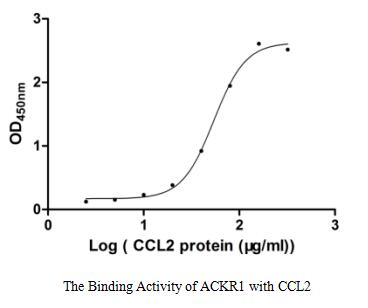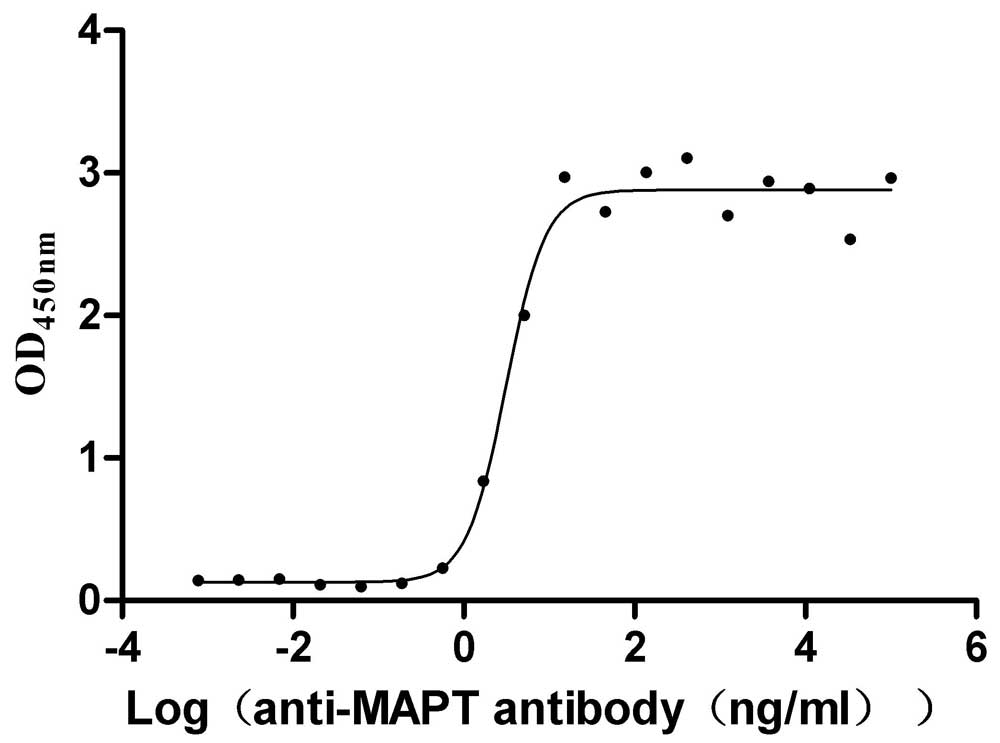Recombinant Human Atypical chemokine receptor 1 (ACKR1) (Active)
In Stock-
货号:CSB-CF624105HU
-
规格:¥9720
-
图片:
-
其他:
产品详情
-
纯度:Greater than 85% as determined by SDS-PAGE.
-
生物活性:Measured by its binding ability in a functional ELISA. Immobilized ACKR1 at 1 μg/ml can bind human CCL2, the EC50 of human CCL2 protein is 48.64-60.24 μg/ml.
-
基因名:
-
Uniprot No.:
-
别名:ACKR1; DARC; FY; GPD; Atypical chemokine receptor 1; Duffy antigen/chemokine receptor; Fy glycoprotein; GpFy; Glycoprotein D; Plasmodium vivax receptor; CD antigen CD234
-
种属:Homo sapiens (Human)
-
蛋白长度:Full Length
-
来源:in vitro E.coli expression system
-
分子量:41.1 kDa
-
表达区域:1-336aa
-
氨基酸序列MGNCLHRAELSPSTENSSQLDFEDVWNSSYGVNDSFPDGDYGANLEAAAPCHSCNLLDDSALPFFILTSVLGILASSTVLFMLFRPLFRWQLCPGWPVLAQLAVGSALFSIVVPVLAPGLGSTRSSALCSLGYCVWYGSAFAQALLLGCHASLGHRLGAGQVPGLTLGLTVGIWGVAALLTLPVTLASGASGGLCTLIYSTELKALQATHTVACLAIFVLLPLGLFGAKGLKKALGMGPGPWMNILWAWFIFWWPHGVVLGLDFLVRSKLLLLSTCLAQQALDLLLNLAEALAILHCVATPLLLALFCHQATRTLLPSLPLPEGWSSHLDTLGSKS
-
蛋白标签:N-terminal 10xHis-tagged
-
产品提供形式:Liquid or Lyophilized powder
Note: We will preferentially ship the format that we have in stock, however, if you have any special requirement for the format, please remark your requirement when placing the order, we will prepare according to your demand. -
缓冲液:Tris-based buffer,50% glycerol
-
储存条件:Store at -20°C/-80°C upon receipt, aliquoting is necessary for mutiple use. Avoid repeated freeze-thaw cycles.
-
保质期:The shelf life is related to many factors, storage state, buffer ingredients, storage temperature and the stability of the protein itself.
Generally, the shelf life of liquid form is 6 months at -20°C/-80°C. The shelf life of lyophilized form is 12 months at -20°C/-80°C. -
货期:3-7 business days
-
注意事项:Repeated freezing and thawing is not recommended. Store working aliquots at 4°C for up to one week.
-
Datasheet & COA:Please contact us to get it.
相关产品
靶点详情
-
功能:Atypical chemokine receptor that controls chemokine levels and localization via high-affinity chemokine binding that is uncoupled from classic ligand-driven signal transduction cascades, resulting instead in chemokine sequestration, degradation, or transcytosis. Also known as interceptor (internalizing receptor) or chemokine-scavenging receptor or chemokine decoy receptor. Has a promiscuous chemokine-binding profile, interacting with inflammatory chemokines of both the CXC and the CC subfamilies but not with homeostatic chemokines. Acts as a receptor for chemokines including CCL2, CCL5, CCL7, CCL11, CCL13, CCL14, CCL17, CXCL5, CXCL6, IL8/CXCL8, CXCL11, GRO, RANTES, MCP-1, TARC and also for the malaria parasites P.vivax and P.knowlesi. May regulate chemokine bioavailability and, consequently, leukocyte recruitment through two distinct mechanisms: when expressed in endothelial cells, it sustains the abluminal to luminal transcytosis of tissue-derived chemokines and their subsequent presentation to circulating leukocytes; when expressed in erythrocytes, serves as blood reservoir of cognate chemokines but also as a chemokine sink, buffering potential surges in plasma chemokine levels.
-
基因功能参考文献:
- The mean number of rosettes formed by erythrocytes surrounding transfected mammalian COS-7 cells which expressed Plasmodium knowlesi Duffy binding protein differ between erythrocytes' Duffy antigen phenotypes. Plasmodium knowlesi Duffy binding protein displays higher binding to Fy(a+/b+) erythrocytes than to Fy(a+/b-) erythrocytes. PMID: 30257710
- The atypical chemokine receptor 1 polymorphism (rs12075) does not affect susceptibility to hepatitis C virus. PMID: 28443566
- The risk of Plasmodium vivax malaria associated with genetic variation of DARC in Thai patients is reported. PMID: 29620340
- Our findings in mice suggest that DARC alters the severity and resolution of AHR. These findings are complimented by our human analyses in which select DARC SNPs are associated with worse asthma control and symptoms. PMID: 28471517
- DARC expression in cancer cells inhibits pancreatic ductal adenocarcinoma progression by suppressing STAT3 activation through the inhibition of CXCR2 signaling PMID: 28214673
- This study reports 1-3 occurrences of P. vivax infection in each of 25 Duffy-negative children at six time points over two rainy seasons and the beginning of the third season. PMID: 28749772
- Data suggest that Type II congenital smell loss patients who exhibit both type I hyposmia and hypogeusia are genetically distinct from all other patients with Type II congenital smell loss. This distinction is based on decreased Fy(b) expression which correlated with abnormalities in two sensory modalities (hyposmia type I and hypogeusia). PMID: 27968956
- The data suggest that selective exposure of the Duffy binding protein (DBP) binding site within DARC is key to the preferential binding of DBP to immature reticulocytes, which is the potential mechanism underlying the preferential infection of a reticulocyte subset by P vivax. PMID: 28754683
- ACKR1 regulates neutrophil counts in blood. Lack of ACKR1 on nucleated erythroid cells together with its expression in endothelial cells causes neutropenia. PMID: 28553950
- population genetic analysis of DARC shows its association with malaria resistance PMID: 28282382
- Molecular identification of rare FY*Null and FY*X alleles in Caucasian thalassemic family from Sardinia. PMID: 25921504
- We showed that DARC expression is down-regulated in CRC and associated with clinical pathological features and MVD of CRC. DARC might be involved in tumorigenesis, progression, angiogenesis, and metastasis of CRC. PMID: 26096170
- DARC is required for Staphylococcus aureus-mediated lysis of human erythrocytes, and DARC overexpression is sufficient to render cells susceptible to toxin-mediated lysis. PMID: 26320997
- the odds for neutropenia in the ACKR1-null (FY-) individuals were 46-fold higher than for FY+ individuals (Crude odds ratio = 46, 95% confidence interval = 8.03-263, P < 0.001) PMID: 25817587
- study demonstrates the association of SNP rs12075 from DARC gene with the levels of serum IL8 PMID: 25647274
- DARC levels are elevated in human keloid fibroblasts and might inhibit the secretion of CCL2. PMID: 26045366
- Through molecular genotyping we also identified polymorphisms in RhCE, Kell, Duffy, Colton, Lutheran and Scianna loci in donors and patients. PMID: 25582271
- The majority of our population is heterozygous for Duffy antigens a and b. PMID: 24929836
- Duffy blood group PMID: 24845979
- Isothermal titration calorimetry studies show these structures are part of a multi-step binding pathway, and individual point mutations of residues contacting DARC result in a complete loss of RBC binding by DBP-RII. PMID: 24415938
- DARC polymorphisms may influence the naturally acquired inhibitory anti-Duffy binding protein II immunity PMID: 24710306
- DARC facilitates CXCL1 inhibition of airway smooth muscle cell migration via modulation of the ERK-1/2 MAP kinase signaling pathway. PMID: 24981451
- The Fy(a-b-) phenotype in three siblings of the Polish family was caused by the FY(*)X/FY(*)B-33 genotype. PMID: 23820435
- DARC antigen is associated with a likelihood for patients to develop leg ulcers in sickle cell disease. PMID: 23753024
- Effect of genetic variants in two chemokine decoy receptor genes, DARC and CCBP2, on metastatic potential of breast cancer. PMID: 24260134
- co-expression of DARC, D6, and CCX-CKR significantly associated with higher survival in gastric cancer PMID: 23462454
- The in fl uence of DARC gene expression on bone mineral density of the mandible was not con fi rmed. PMID: 22910367
- DARC and BCAM expression was associated with pathogenesis of thyroid carcinoma and correlated with clinical-pathological features. PMID: 23168236
- The high frequency of the FYES allele that silences erythroid expression of the Duffy antigen offers a biologically plausible explanation for the lack of Plasmodium vivax infections observed. PMID: 23347639
- Although lower, the risk of Duffy-negatives to experience a P. vivax blood stage infection was not significantly different to that of Duffy-positives. PMID: 23259672
- strong associations between SNPs in DARC gene, particularly rs12075, and serum MCP-1 levels identify a potential candidate gene that can be explored for its role in inflammatory pathways; replication of European GWAS of MCP-1 in study of Hispanic children confirms importance of DARC in regulation of MCP-1 PMID: 23017229
- vivax malaria incidences over the past five years in an Indian population were significantly negatively and positively associated with the frequencies of the FY*A and FY*B alleles of the Duffy gene, respectively. PMID: 23028857
- platelet molecule platelet factor 4 (PF4 or CXCL4) and the erythrocyte Duffy-antigen receptor (Fy) are necessary for platelet-mediated killing of Plasmodium falciparum parasites. PMID: 23224555
- Data suggest that DARC (Duffy antigen receptor for chemokines) gene may play an important role in regulating the metabolisms of both lean body mass (LBM) and age at menarche (AAM). PMID: 22744181
- We developed a phylogenetic tree for DARC alleles and postulated a distinct FY*B allele as ancestral for the extant DARC alleles in humans. PMID: 22082243
- Our results provide evidence that the functional rs2814778 polymorphism in the gene encoding DARC is associated with worse clinical outcomes among African Americans with ALI, possibly via an increase in circulating IL-8. PMID: 22207676
- Data show that in ancestry to the African continent (AA) subjects, the region surrounding the Duffy antigen/chemokine receptor gene (DARC) on 1q21 exhibited significant association with white blood cell count (WBC) levels. PMID: 22037903
- findings show that Fy(a), compared with Fy(b), significantly diminishes binding of Pv Duffy binding protein (PvDBP) at the erythrocyte surface, and is associated with a reduced risk of clinical Plasmodium vivax in humans PMID: 22123959
- It seems that this version of DARC receptor is a powerful facilitator of chemokine transcytosis and subsequently leukocyte migration into GVHD target organs. PMID: 21784153
- Here we describe the recent success in mapping the gene that underlies benign neutropenia in African American populations. We discuss the known function of the gene and consider potential mechanisms for the effect on neutropenia.[review] PMID: 22097233
- despite an association of CCL2 serum levels with the severity of liver fi brosis, a functional SNP in the CCL2 scavenger receptor DARC is not directly associated with the occurrence or the severity of liver disease in hepatitis C infection infection PMID: 21156192
- DARC -46C/C results in loss of DARC expression on erthyrocytes (Duffy-null) and resistance to Plasmodium vivax malaria, and subjects with this genotype had pre-HIV seroconversion neutrophil counts of <2500 cells/mm(3). PMID: 21507922
- DARC and D6, the most studied members of this group of molecules, are reviewed. PMID: 21151196
- results do not support an effect of erythrocyte DARC expression on the risk or progression of prostate cancer in men of African descent. PMID: 20596779
- This activation state associated with DARC RBC expression may influence the intensity of the inflammatory responses encountered in sickle cell anemia and participate in its interindividual clinical expression variability. PMID: 21088296
- Duffy Antigen Receptor for Chemokines (DARC) is an unusual transmembrane chemokine receptor which binds the two main chemokine families. PMID: 20655787
- Plasmodium vivax is able to infect and cause Malaria vivax in Duffy-negative people. PMID: 20655790
- Results indicate that one of the primary mechanisms by which P. vivax evades host immunity is through DARC indirectly down-regulating humoral responses against erythrocytic invasion and development. PMID: 20664684
- Genome-wide association analysis finds strong association for serum MCP-1 with a nonsynonymous polymorphism, rs12075 (Asp42Gly) in DARC. PMID: 20040767
- Duffy-positive sickle cell anemia patients exhibited higher counts of white blood cells, polynuclear neutrophils, higher plasma levels of IL-8 and RANTES than Duffy-negative patients. PMID: 20347396
显示更多
收起更多
-
亚细胞定位:Early endosome. Recycling endosome. Membrane; Multi-pass membrane protein. Note=Predominantly localizes to endocytic vesicles, and upon stimulation by the ligand is internalized via caveolae. Once internalized, the ligand dissociates from the receptor, and is targeted to degradation while the receptor is recycled back to the cell membrane.
-
蛋白家族:G-protein coupled receptor 1 family, Atypical chemokine receptor subfamily
-
组织特异性:Found in adult kidney, adult spleen, bone marrow and fetal liver. In particular, it is expressed along postcapillary venules throughout the body, except in the adult liver. Erythroid cells and postcapillary venule endothelium are the principle tissues exp
-
数据库链接:
HGNC: 4035
OMIM: 110700
KEGG: hsa:2532
STRING: 9606.ENSP00000357103
UniGene: Hs.153381
Most popular with customers
-
Recombinant Macaca mulatta Microtubule-associated protein tau (MAPT) (Active)
Express system: Mammalian cell
Species: Macaca mulatta (Rhesus macaque)
-
Recombinant Human Mucin-17 (MUC17), partial (Active)
Express system: Mammalian cell
Species: Homo sapiens (Human)
-
Recombinant Human Claudin-6 (CLDN6)-VLPs, Fluorescent (Active)
Express system: Mammalian cell
Species: Homo sapiens (Human)
-
Recombinant Human Claudin-3 (CLDN3)-VLPs (Active)
Express system: Mammalian cell
Species: Homo sapiens (Human)
-
Recombinant Human Myosin regulatory light polypeptide 9 (MYL9) (Active)
Express system: Yeast
Species: Homo sapiens (Human)
-
Recombinant Human Interleukin-1 receptor accessory protein (IL1RAP), partial (Active)
Express system: Mammalian cell
Species: Homo sapiens (Human)
-
Recombinant Human Tyrosine-protein kinase receptor UFO (AXL), partial
Express system: Mammalian cell
Species: Homo sapiens (Human)






f4-AC1.jpg)














